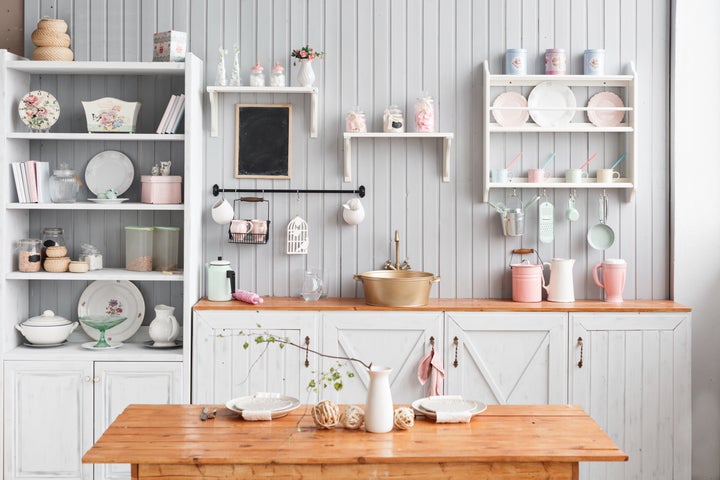The first episode of Marie Kondo’s ‘Tidying Up’ sees a couple take on the mammoth task of decluttering their entire house. It’s an exhausting exercise – especially with two young children – but in the end they succeed and live happily ever after.
We all know Kondo for her cut throat approach to chucking out clothes, and indeed the episode focuses heavily on the couple’s wardrobe. But another area that’s often in desperate need of a clear-out, yet is often overlooked, is the kitchen.
We briefly see Kondo sweep through the couple’s kitchen, but by the end viewers are left with little more than a handful of tips on storing utensils. So how else can you declutter your kitchen?

Kate Ibbotson is a declutter expert and professional organiser at A Tidy Mind. She tells HuffPost UK that the kitchen is a good place to begin when decluttering as the items are generally ‘low emotion’ – in other words, you’re less attached to them so decisions can be made quickly and easily.
“Decluttering this room has a high impact,” she explains. “The items we do decide are superfluous to requirements can be bulky and numerous so we see a huge difference in terms of creating space and order. In turn, this spurs people on to embark on the next project.” Sounds good, so where do we begin?
What To Ditch
“Bin, scrap or pass on the stuff you don’t want immediately,” says Cath Hindle, from Clear The Clutter. “Pass it on groups on Facebook are great for this.” Equally if it’s good secondhand kitchen equipment, you could sell it on sites such as Ebay or Gumtree.
Out-of-date food is the first to go, as is crockery and cutlery that you only ever use once. Got duplicates of utensils, such as two garlic crushers? Ditch one.
Next up are the items which you wouldn’t use because you own something else that does the same job. For example, you own an egg timer but you just use the cooker clock or your phone timer. Bye bye, egg timer.
Takeaway menus should also be binned if you can just look the menu up online. “Also avoid loose paperwork in the kitchen,” says Ibbotson. “Create a specific command station for incoming mail and stick notes and reminders on a noticeboard.”
Ibbotson also recommends letting go of items which are meant for your ‘fantasy self’. “To some that might mean a bread maker, because they are not the sort of person to make bread. Or items which date back to a different life stage – one you have moved on from,” she explains. “Just because something has a use, it doesn’t mean you will use it.”
And lastly, beware of the kitchen junk drawer (we all have one). “Assign a home for every little thing to avoid drawers becoming dumping grounds,” she adds.
What To Keep
You should aim to only keep items that you use within the vicinity of that space, says Hindle. “Mugs above the kettle, baking trays next to the oven, pans near the hob. By thinking about the stuff you do use, you will automatically whittle out the stuff you don’t.”
You might also choose to keep a sewing kit or medication in the kitchen, if that’s where you tend to use it. “Aim to keep surfaces clear apart from daily used items because this will make it as easy as possible to clean,” says Ibbotson.

How To Organise
Now for the fun part. Drawer dividers (£20, Ikea) can help for the dreaded kitchen junk drawers, says Ibbotson. And use transparent containers (£12.99 for a pack of 10, Amazon) for different categories of food, which can be used inside or outside of cupboards.
Hindle says: “A good tip is use to use small tupperware container or take away boxes to store things like clips and bottle openers. They still fit in your drawers but allow you to group things.
“Speaking of plastic food containers, if space allows, stack the bottoms in one drawer and the lids in the drawer above. It makes them much easier to pair up.”
Ibbotson recommends organisation tools to maximise cupboard space, such as turntables (£11.67, Amazon) and tension rods (£7.99, Amazon) to rest trays against. You can also try stepped organisers (£11.99, Amazon), which basically double up the space in your cupboard as you can pop tins, cups or plates and bowls underneath and on top of them.
If space is at a minimum elsewhere, attach spice racks to your walls (£12.99, Wayfair) or put up some shelves (prices vary, Ikea). You can also buy magnetic strips to attach knives to (£2.99, Amazon). Tiny cupboards? Consider getting some hooks suspended from the ceiling or walls (£72, Not On The High Street) to hang pans on – just mind your head.
Organising your food is also important. Regularly check for out-of-date products, says Hindle, and don’t put newly bought items in front of old stuff. “That’s how you end up with lots of corned beef in the back of the cupboard.”
Store similar products together and if possible stack tins, she advises. Another handy tip: “If you cook with herbs and spices, use a shoe box to store the jars in and write the name on the top of each one so you can easily locate what you need.”
We all work hard to earn our money – so it shouldn’t feel like hard work to spend it well. At HuffPost Finds we’ll help you find the best stuff that deserves your cash, from the ultimate lipstick to a durable iron to replace the one that broke (RIP). All our choices are completely independent but we may earn a small commission if you click a link and make a purchase.